Years ago, programmers were a necessity to run and manage a tech-forward company. But these days, advancements in technology have given everyone an equal chance when it comes to software.
It doesn’t matter whether you’re an entrepreneur, a virtual assistant, or a marketing manager, you can automate and simplify workflows without even writing a single line of code.
It’s not hard to understand why no-code platforms are rapidly gaining traction among small businesses; 90% of no-code tool users say that their workplace operations got streamlined, work environments improved, and growth was faster thanks to the best no-code tools.
But with the software space growing rapidly, how can you pick the best ones for your small business?
That’s where this list comes in.
Here, we’ll discuss the best no-code tools in the following categories:
- Website builders
- Form builders
- Integration platforms
- ECommerce builders
- Blog makers
- Project management software
- App and product builders
- Social media marketing planner
- Affiliate marketing software
- Business communications collaboration software
- Virtual events platform
This way, you can make the most out of your ideas, improve your processes, save time, and serve a better product or service to your customers—without needing to fork out a lot of money. You can do all these — even if you’re not a coder or tech-savvy.
Let’s dive in
1. Wishpond (Website Builder)
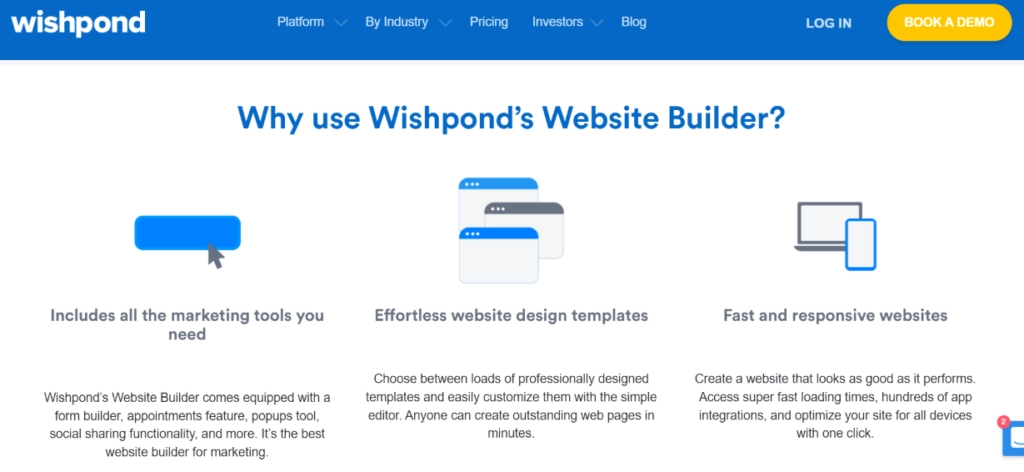
What is it?
Wishpond is a website builder equipped with an arsenal of marketing tools like forms and pop-ups, email marketing, marketing automation, leads database, social promotions, and eCommerce selling. A website builder for all, Wishpond allows you to scale operations whether you are a small or medium-sized business. It goes beyond the standards of most website builders and includes marketing services with a team of professionals like content writers, designers, and ad specialists who can create campaigns for you.
Wishpond’s website builder is part of the platform’s all-in-one marketing solution.
Why we love it
If you’re looking to align your marketing team members and strengthen your current marketing strategies, it’s the ideal tool for you. It works on desktop, online, and iOS and Android apps. Plus, it comes with in-depth behavior reports, extensive automated workflows, ready-made website templates, and more.
Pros
- Feature-rich and provides an all-in-one marketing solution
- The interface is powerful, user-friendly, and straightforward
- Transferring data to other CRM systems is fast and easy
- Integrates with Insightly, Salesforce, and about 40 reputable services
- Responsive support team with 24/7 availability
Pricing
2. Paperform (Form Builder)

What is it?
Paperform is an online form builder, built to help small businesses cut down on busywork, minimize their budget and simplify life.
The tool can easily be customized to manage any type of project – create online lead generation forms, take payments or sell products, schedule appointments and automate workflows without any technical knowledge. As simple as writing a document, fully customize your forms to be as unique as your brand.
What we love about it
The Paperform platform combines beautiful design and digital smarts. Add custom pricing, curate your own unique color palette, upload complex calculations, and design tailored success pages. An example of its versatility would be the fact you can turn a form into an eCommerce product landing page with its own custom pricing and if you like, incorporate monthly subscriptions, coupons, invoices, and a built-in inventory management system that allows you to track available stock.
However, if you want a greater range of marketing functionality, then it might be worth looking towards an all-in-one marketing solution like Wishpond that includes a no-code, template-based form builder as well as a wide range of other integrated marketing tools.
Pros:
- Unlimited forms with unlimited fields
- 650+ form templates
- Conditional logic support
- Automated workflow capabilities
- 3,000+ integrations to popular apps
Cons:
- No free plan
- Paperform branding only removable in the Pro plan
- Limited to only creating forms
- A more expensive form builder
Pricing:
- Essentials – From $20/month
- Pro – From $40/month
- Agency – From $135/month
3. Zapier (Integrations)
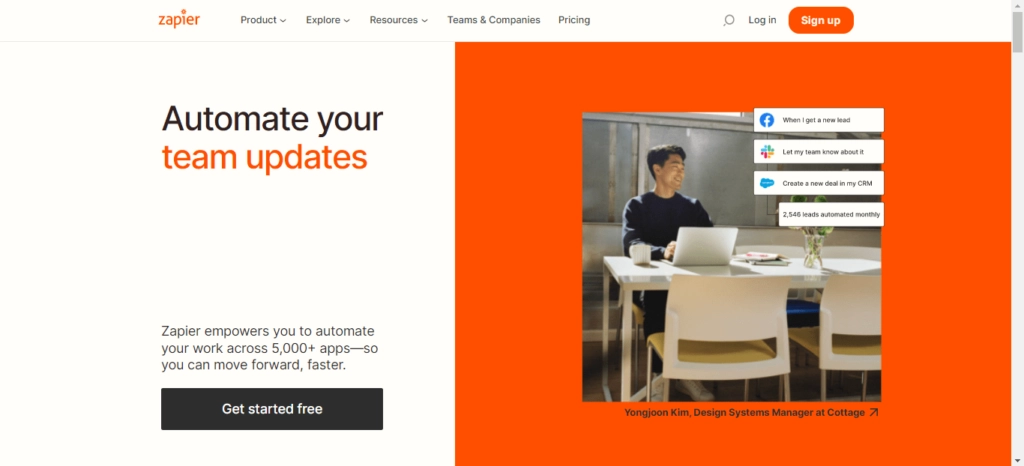
Source: Zapier.com Zapier homepage.png
What is it?
Zapier is a web automation tool that connects with over 5,000 apps and services to help automate tedious tasks. All you have to do to connect to popular applications like Gmail, Slack, Evernote, and Dropbox, choose a trigger and decide what the action is. You can use Zaps to automate your blog, send emails, create tasks in Asana from Slack messages, or back up new contacts from a Google Sheet.
Why we love it
Zapier is a great tool for small businesses that require automation to improve efficiency and save time on menial tasks without needing to hire extra manpower.
Pro
- Offers a wide range of integrations
- Helps automate and simplify complex workflows
- Built-in guidelines to help assist app integration
- User-friendly interface
Cons
- Limited free trial functionalities
- Steep learning curve for non-techies
Pricing
- Free: $0/mo (The basics)
- Starter: $19.99/mo (750 tasks a month)
- Professional: $49/mo (2000 tasks a month)
- Team: $299/mo (50000 tasks a month)
- Company: $599/mo (100000 tasks a month)
4. Make (Formerly Integromat)
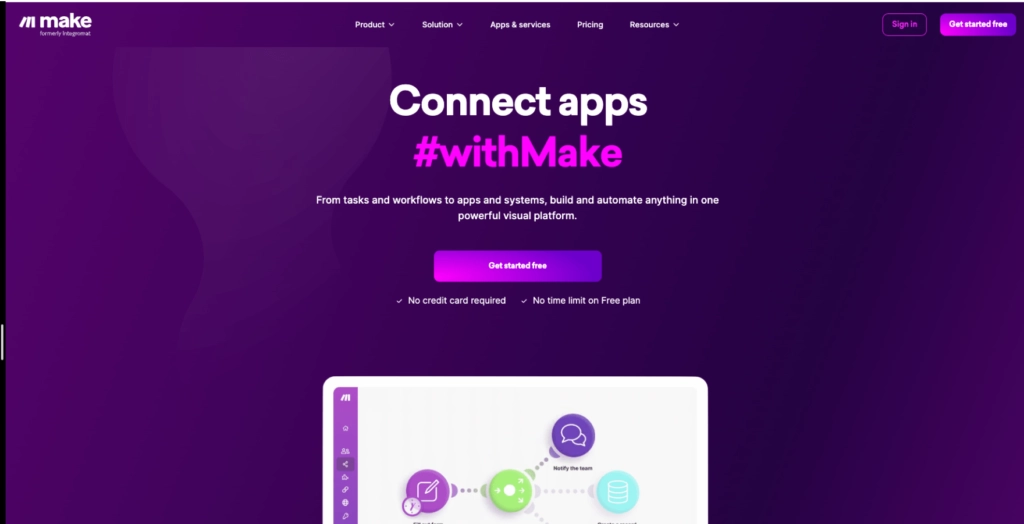
What is it?
Like Zapier, Make is a no-code web-based tool that allows users to automate online tasks. Using a mind-map-like visual builder, users can connect various apps. Watch data flow in real-time and create workflows within minutes on the Make platform. With Make, business workflows can be triggered by events or run on a designated schedule.
While Zapier has three times more integrations than Make, most business integrations are supported by Make.
Why we love it
As an alternative to Zapier, Make edges out against Zapier in that it supports multiple-step workflows in its free plan. If you’re like us and love to visually build workflows, Make’s visual design also means that imagination is the limit when it comes to solving complex problems.
It’s also much better at allowing users to troubleshoot errors thanks to a built-in testing report feature that shows where exactly a problem occurred.
Pro
- Helps visualize tasks
- Supports multi-step workflows
- Easy error report
- Less expensive than Zapier
Cons
- Fewer integrations
- Not as straightforward as Zapier
Pricing
- Free: $0/mo
- Core: $9/mo
- Pro: $16/mo
- Teams: $29/mo
- Enterprise: Custom price
5. Shopify (eCommerce Builder)

What is it?
If you’ve ever wanted to build and manage your own online store, Shopify is a leading eCommerce platform that enables businesses of all sizes to do just that. Shopify allows entrepreneurs to launch and market an eCommerce business online without any technical knowledge to set up. Whether you run a home business, a brick-and-mortar store, or a large retailer, All of Shopify’s features can help take your product online.
Why we love it
Shopify is often a small business owner’s go-to eCommerce software if they want something easy to manage that doesn’t take too much time to set up. Building a store isn’t just a matter of money, but time as well. If you can’t afford to dedicate hours to updating products, inventory, or other store processes Shopify is great.
Pro
- Scalable platform
- Easy to use
- Many apps aimed to convert
Cons
- Transaction fees on lower-tier plans
- High-conversion themes behind a paywall
Pricing
- Basic plan: Starts at $29 per month
- Medium plan: Starts at $49 per month
- Advanced plan: Starts at $299 per month.
6. Hubspot (Blog Maker)
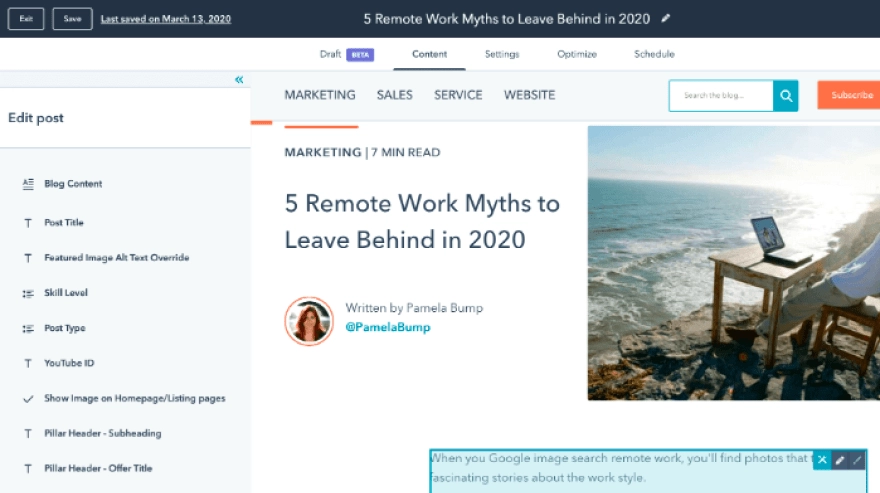
What is it?
HubSpot’s free blog maker allows you to easily create and edit blog posts with a visual editor and custom domains. You can draft your blog content and schedule publishing in advance.
Why we love it
We love the free blog maker because it’s easy to use. Even if you have an existing blog, you can migrate it over using a number of blog import tools. Their blogs are visually appealing too – they offer both free and paid blog theme options available in their Asset Marketplace. Additionally, marketers can use it to create effective content for your blog. You can design homepages, publish blog posts, upload media, and more. You also have the privilege of A/B testing landing pages.
Pros
- Allows readers who subscribe to be notified via email anytime you publish a new blog. These notifications are completely personalized based on preference.
- Offers built-in AMP (accelerated mobile pages) support offering an optimized experience whether it’s a tablet, mobile phone, or laptop.
- Responsive support team with 24/7 availability
- Responsive, simple, and easy-to-use templates
Cons
- You need to upgrade to the paid version if you would like to host multiple blogs.
- Only allows you to host a blog up to 100 posts on the free plan
Pricing
- Free Plan available
- Starter – $45/mo
- Professional – $800/mo
- Enterprise – $3,200/mo
7. Clickup (Project Management Software)
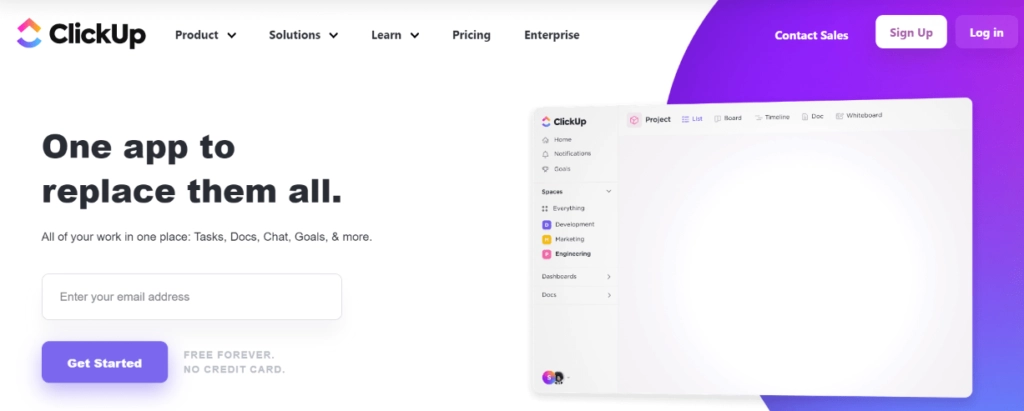
What is it?
ClickUp is one of the best no-code tools and project management programs out there. It has a ton of useful features for small businesses and solopreneurs. It adds fun to the concept of project management.
Its most outstanding features? The ability to present custom views and invite guests! This feature may be simple, but considering 18% of projects fail because of outdated project management software and it’s something that most programs lack, we couldn’t recommend it enough. What it does is allow the user to view a task according to their preference and let guests chip in for reviews. As a result, it improves team unity, sharpens organization, and encourages more effective collaboration.
Pros
- Amazing visual appeal with a customizable and easy-to-use dashboard
- Feature-rich, enticing, and powerful
- Efficient sub-task management system
- Saves data in a repository and has an incredible recovery system
- Responsive support team with 24/7 availability
Cons
- Steep learning curve and not for beginners
- The task hierarchy can get confusing
Pricing
- Free Forever
- Unlimited – $5/mo (per member)
- Business – $12/mo (per member)
- Business Plus – $19/mo (per member)
- Enterprise – Custom
8. NiftyPM (Project Management)
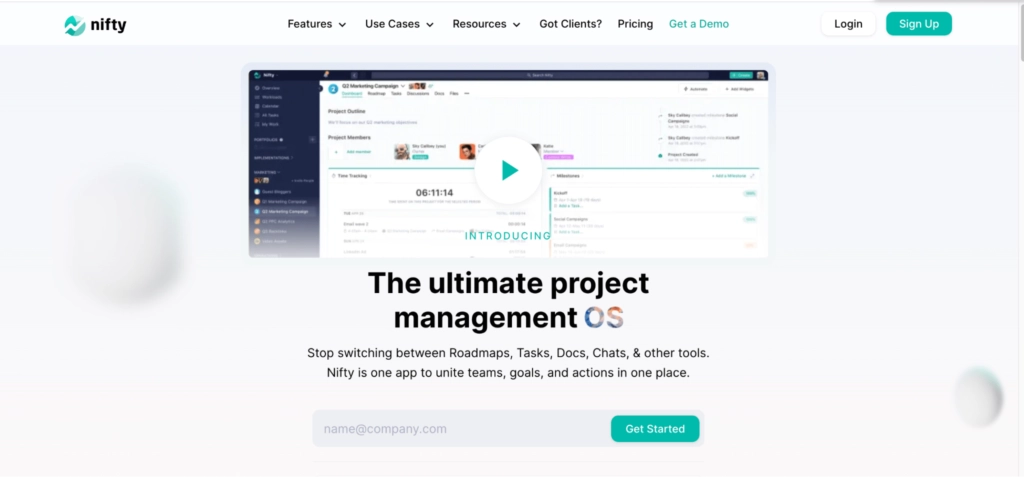
What is it?
Nifty is an all-in-one Project Management and Collaboration tool. Nifty is a fantastic option for product and service companies alike. Chances are that, if you’re reading this, you’re not a project manager, which is why you’ll find Nifty’s ease of use extremely valuable. Teams of all sizes and experience with tech find it easy to create projects, manage client relationships, and even chat amongst the team from a single tool on mobile, browser, or desktop.
Pros:
- Project Roadmaps break projects into phases known as Milestones which report progress in real-time as the Tasks within them are completed.
- Project Discussions as well as a team-side Direct Messenger improves team collaboration.
- You can even create brand new or import existing Google Docs and work on them from inside of Nifty.
Cons:
- Nifty doesn’t offer the same volume of reporting metrics as some of its contemporaries.
Pricing:
- Freemium
- Basic – $5/user/month on an Annual basis
- Pro – $10/user/month
- Business – $16/user/month
9. Softr (App Builder)
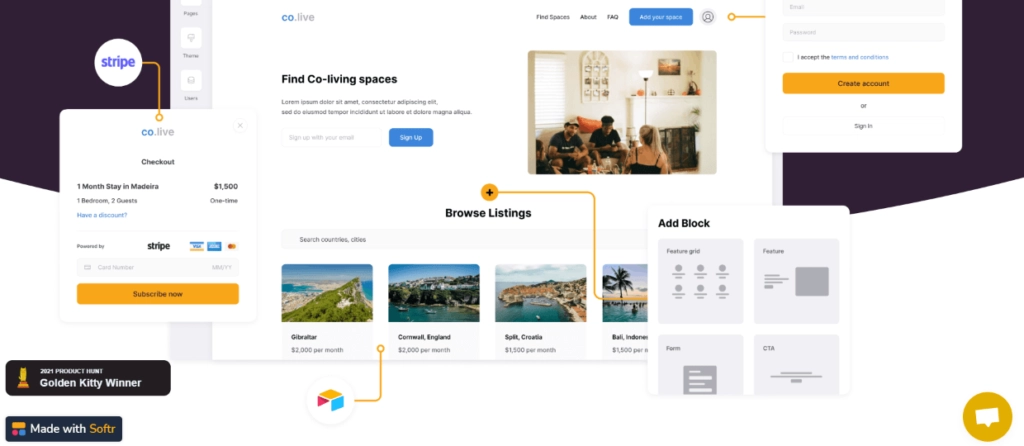
What is it?
Another great no-code tool with a minimal learning curve is Softr. It turns your Airtable databases into web apps and client portals. Users have built Customer Relationship Management tools, online marketplaces, and social networks
Why we love it
On its own, this no-code tool holds a staggering reputation for its usefulness. With expertly made templates and dozens of direct integrations like Mailchimp, Hubspot Chat, Zapier, and Hotjar you can create bespoke apps that are easily integrated into your existing systems. And, because it features custom code (CSS and HTML), it can guarantee a positive user experience across visual and creative elements.
Pros
- Payment, media, and analytics templates
- Possible to build progressive web apps with Softr, achieving an experience close to native mobile apps
- Features a responsive design with (at least) 100 building blocks
- Enables users to send data to services with Custom Forms
- Dynamic search and filtering capabilities
- Video Embedding
- Responsive support team with 24/7 availability
Cons
- The autosave feature can be problematic
- Limited template and pre-designed blocks available.
- Only possible to use Airtable as a data source, but Google Sheets and other options are coming soon.
Pricing
- Free
- Starter – $24/mo
- Professional – $65/mo
- Business – $165/mo
10. Bubble.io (App/Product builder)
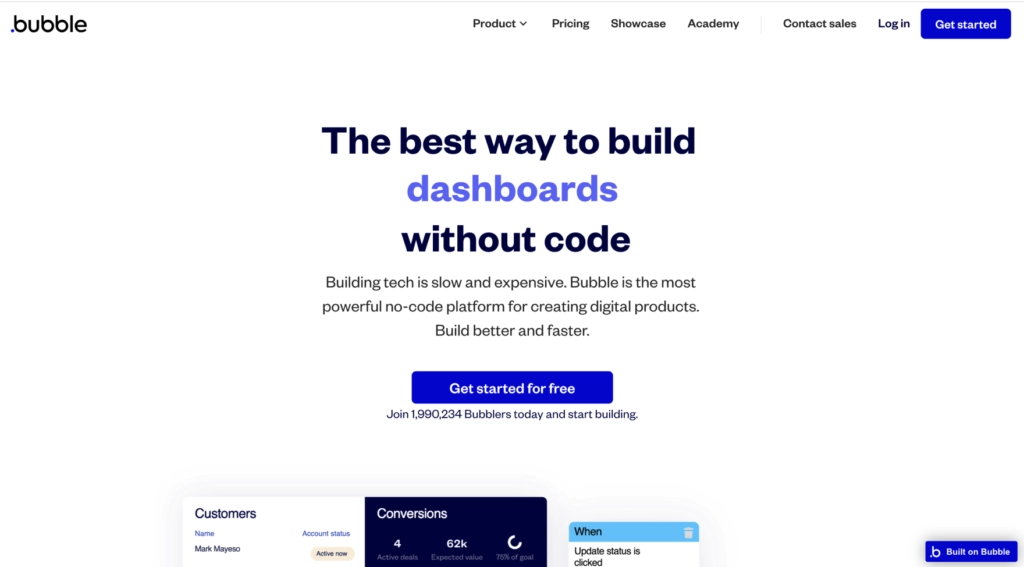
What is it?
Bubble.io is a platform that enables users to create a website or app without having to write any code. Whether you wish to build something as complex as a home rental app or a simple portfolio website, this is a way to do so without writing a single line of code.
Bubble takes care of all the technical aspects of running your app so that you don’t have to worry about deploying or hosting your app. Develop dynamic content through a drag-and-drop interface, create multilingual apps automatically, and never be limited to the storage, volume traffic, and number of users you can have on your app.
Pros:
- No need to learn how to code HTML or CSS
- Build any type of mobile application
- Also allows API integration
Cons:
- Slow PageSpeed Insights scores
- Reliance on Bubble’s premade styles
- Better plugins locked behind higher-paid plans
Pricing
- Free: $0/mo (All you need to learn core platform features)
- Personal: $25/mo (Everything in the free plan + custom domain, API, and support)
- Professional: $115/mo (3 units of server capacity, 2 app-editors, and everything in Personal)
- Production: $475/mo (10 units of server capacity, 15 app-editors, and everything in Professional)
11. Planable (Social Media Marketing Planner)
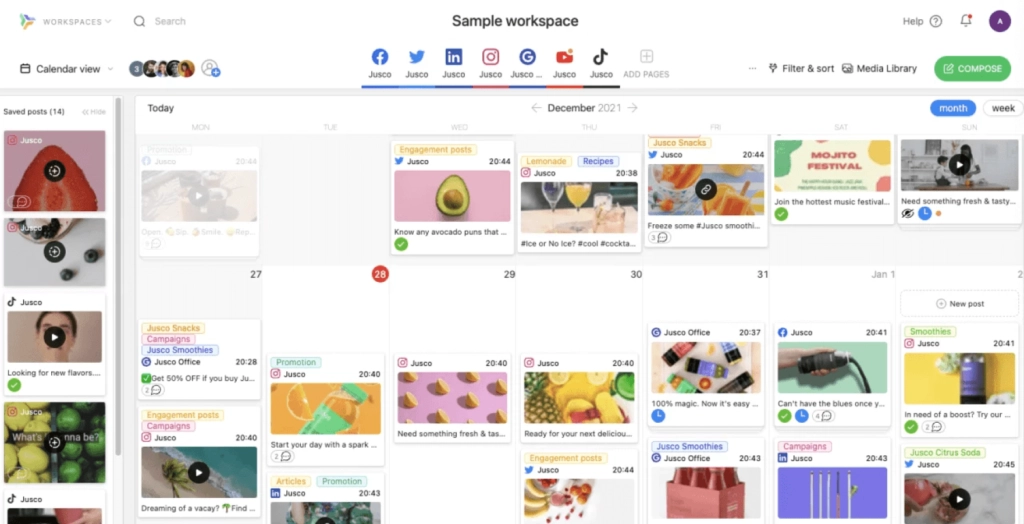
What is it?
Planable is a social media management tool that makes it easy to plan, collaborate on, and schedule your content in advance. Think of it as a centralized data hub where you can store ideas and content. Plus, it’s best for anyone who wants to fuel their social media marketing strategy — both individual marketers and agencies.
With Planable’s social media calendar, you can create posts for 7 social media platforms and share them with your team so they can provide feedback and approve upcoming posts. It’s an ideal tool for anyone with multiple accounts who needs a social media time-saver.
Why we love it
We love Planable because it’s an easy-to-use tool for any organization that wants to improve its social media presence. The intuitive interface shows you exactly what your posts will look like when they go live. This means fewer mistakes and unpleasant surprises on your social media profiles.
Pros
- Enables fast content collaboration
- Easy approval workflow for coworkers and clients
- Recurring posts feature
- Impressive mobile app
- Commendable customer support
Cons
- No analytics
- Bulk content can be difficult to customize
Pricing
- Free Plan available
- Basic Plan: $11/user
- Pro Plan: $22/user
- Enterprise Plan: custom – get in touch for more details.
12. Scaleo (Affiliate Marketing Software)
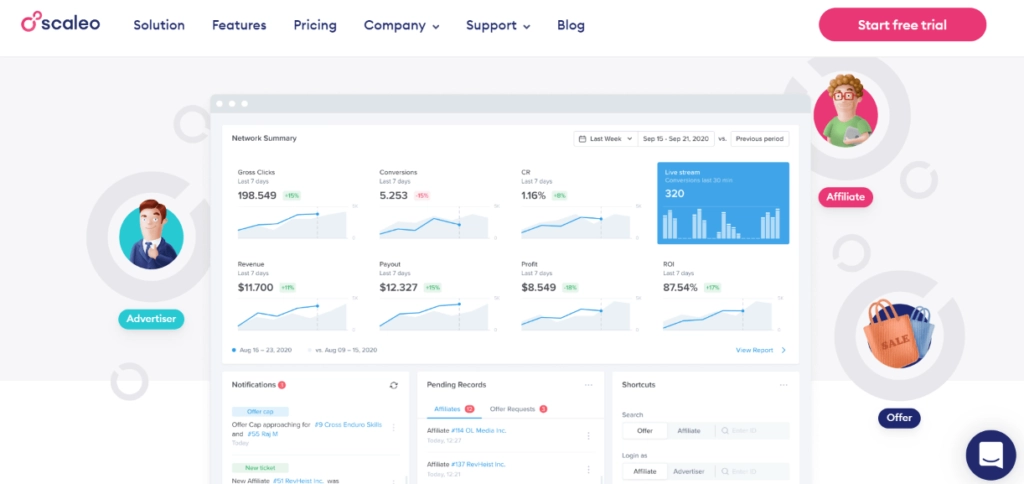
What is it?
Scaleo is an affiliate marketing software and a tracking platform. It helps with monitoring, analysis, and optimization. For advertisers, ad agencies, and affiliate networks, it’s one of the best no-code tools that offer a useful solution. It’s also ideal for brands who want to branch out and venture into affiliate marketing. Because it’s effortless to set up, you can rely on it to have an operational affiliate marketing branch fast.
It deserves a spot on the list of the best no-code tools because it works effectively. It comes with an advanced tracking system — courtesy of Google Tag Manager for a cookie-based tracking scheme. If you are about to enter the world of affiliate marketing, you need this no-code tool. After all, experienced affiliate marketers know that even though it’s lucrative, running an affiliate marketing program can be confusing. With Scaleo, though, you can monitor your efforts better and faster.
Pros
- Feature-rich with customizable, easy-to-use, and real-time reporting
- Provides widgets and white-label solutions
- Integrates with OpenCart, Big Commerce, CS-Commerce, and other eCommerce platforms
- Responsive customer support team
- The user interface is modern and edgy with a lightning-fast navigational speed
Cons
- Managing conversions isn’t easy because the reports aren’t in-depth
- Limited availability of languages
Pricing
- Professional – $299/mo
- Enterprise – $499/mo
- Custom – $999/mo
13. Demio (Webinar Platform)
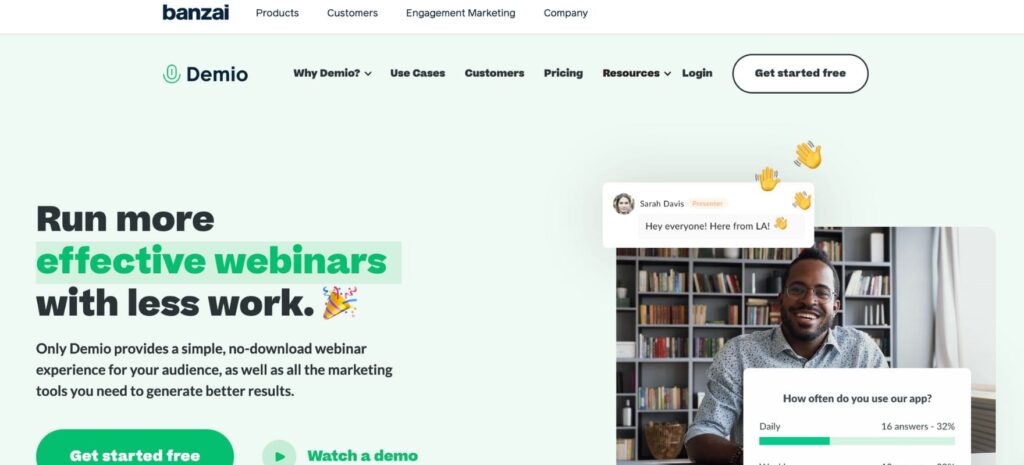
What is it?
Demio is a webinar platform built by marketers, for marketers. The entire platform is built around attendee engagement and lead interaction. Marketers can use Demio to run various types of webinars, such as live, automated, on-demand, and hybrid sessions. Demio makes webinars easy to plan and enjoyable to attend.
Why we love it
The company’s focus on meeting marketers’ needs sets Demio apart from other platforms. The software fully aligns with a marketing team’s workflow, focusing on effective webinar design, excellent user experience, and attendee engagement.
Pros
- Use company branding on Registration, Replay, and Thank You pages, as well as the event room itself.
- Create email notifications to remind registrants about their upcoming sessions.
- Organizers can craft unique engagement experiences through interactive polls, offers, calls to action, and more.
- Track registrations to understand how people watched the webinar, and view and export the breakdown of every feature launched during the session with Demio’s analytics.
- Demio integrates with top marketing apps organizers already use, like HubSpot, Marketo, ActiveCampaign, and more.
- Real-time streaming.
- 24/7 dedicated support.
Cons
- No native place to accept payments
- No desktop app (this is a con for some people although we love that Demio is completely browser based)
Pricing
- The Starter plan – $49/month and includes a 50-attendee room.
- The Growth plan – $99/ month.
- The Premium plan – custom quote.
14. Nextiva (Business Communications Collaboration Software)

What is it?
NextivaONE is software that allows your business to grow and stay productive by simplifying all communications. NextivaONE brings all conversations together in a single application that lets you manage communication, team collaboration, and customer engagement in one place.
Why we love it:
Helps simplify your tech stack. Nextiva puts all communications, VoIP phone calls, text, video, and email, as well as team collaboration integrated into a single platform. Plus, the prized feature called Threaded Conversations brings together all communications with a customer – be it text, email, voicemails, etc – into a single conversation thread. No more shuffling between apps or flipping to your inbox to find the most recent contact – it’s all in one thread, making it easy to manage your customer records and communications.
Pro:
- Easier collaboration with team members. Provide the information you and your team need instantly.
- Projects, teams, files, links, etc., are all searchable within the same screen.
- Schedule video conferences with your teams, clients, or guests without having to switch apps.
- Ability to automate reminders for your team or customers.
- Integrate any tool you use into the Nextiva app.
Cons:
- Not a task management tool
- Voice component required to enable additional features
Pricing
Pricing is dependent on the number of employees: 1-4, 5-19. 20-99. 100+. From there you can choose between their Essentials, Professional and Enterprise packages. See their website for more details.
15. Airmeet (Event Platform)
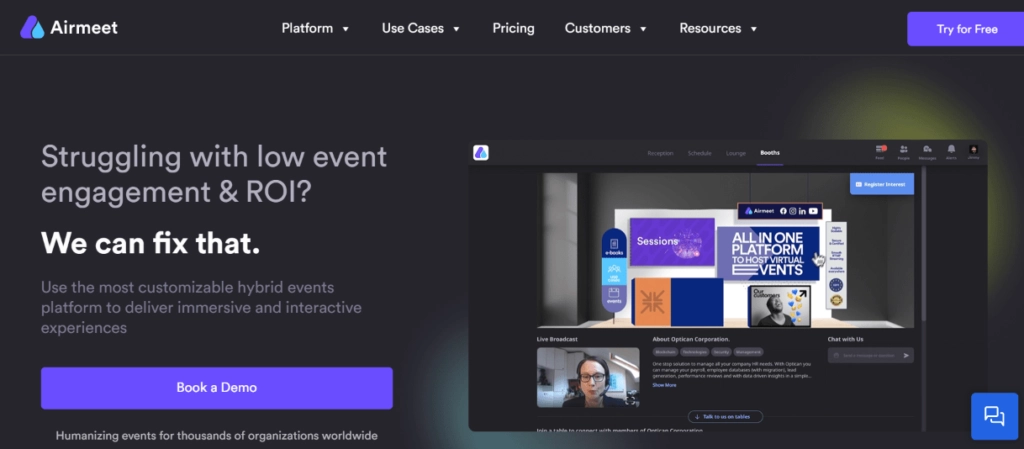
What is it?
Airmeet is a cloud-based hybrid and virtual event platform with winning features like Vendor Management, Audience Analytics, and exhibitor functionalities. It caters to both hosts and attendees who want to participate in a momentous event.
Hosts will appreciate functionalities like role-based access, branding, and multi-language support. Meanwhile, attendees will be grateful for attendee networking, floor plans, and other unique functions. Its goal is simple: bolster event engagement rates and increase the profitability of businesses. And based on its range of features and technical performance, it accomplishes the goal.
Pros
- Feature-rich with customizable reports and attendee tracking systems
- Integrates with popular platforms like Mailchimp, Marketo Engage, and Zapier
- Grants the ability to host a massive conference — open to 100,000 attendees
- Sponsorship tiers, networking tables, and other amazing sponsorship functionalities
- Excellent customer support team
Cons
- Occasional technical issues with audio dropping
- Not mobile-friendly and compatible with Safari and other popular programs
Pricing
- Free
- Standard – $200/mo
- Pro – Custom; from $7,500/yr
Conclusion
The no-code (and low-code) platform development market is growing at a rapid rate — In 2013, the market’s value was $10.3 billion. By 2030, predictions say that it’s in line with its CAGR and can generate a revenue of $187 billion.
Aside from the growing popularity of the best no-code tools, there are many great reasons to use them. One of the top reasons is their advantage of providing lower risks to you. With them, you don’t have to worry about not having in-depth technical knowledge anymore. You can go ahead and concentrate on launching brilliant ideas to life — create and customize apps and offer a positive user experience.
In this day and age, knowing how to code is valuable. But what’s also valuable is your ability to be resourceful. The best no-code tools are out there and despite not knowing how to write code, you can use them to support your idea.
___
Kayleigh Berry is an SEO marketer at Paperform. Her strong history in psychology, marketing, and creativity, combined with her 100 miles per hour personality, keeps her up to date with all the latest trends in the new and changing digital marketing industry. Outside of work, you’ll find Kayleigh surfing or training her Australian Shepherd puppy.

